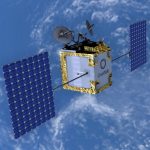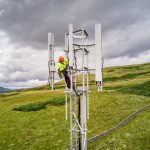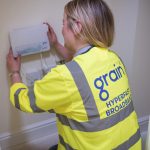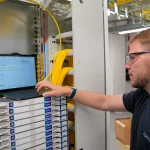Royal Astronomical Society Criticises LEO Broadband Satellites

The Royal Astronomical Society (RAS) has warned that new Low Earth Orbit (LEO) based ultrafast broadband satellites, such as from SpaceX’s Starlink and British-registered OneWeb, will have a “significant” impact on radio astronomers and could put at risk hundreds of millions of pounds of UK investment in space research.
At present OneWeb and Starlink are both in the process of launching thousands of compact LEO satellites, which orbit much closer to the Earth – often at an altitude of around 500-1300km – than the older generation of double-decker bus sized geostationary orbit communication satellites (c.35,000km).
When matched by enough ground stations and the right technologies, these new LEO mega constellations can deliver 100Mbps+ class broadband speeds with fast latency (c.20-50ms) to some of the remotest and hardest to reach areas. This in turn could, eventually, help to support the UK Government’s ambitions to improve rural broadband coverage.
Advertisement
However, such vast networks have already caused anger among scientists around the world, particularly those engaged in scientific research and observations of space and the wider universe. So far, much of this anger has focused upon the impact around visual observations (i.e. LEOs showing up as multiple streaks in telescope images etc.), but that’s not the only area of “interference“.
At present, Ofcom is currently consulting on several licensing changes (here) to help support the new LEO satellites and tackle any potential interference. But the RAS warns that the UK telecoms regulator has made no proposal to include the impact on ground-based passive radio users, such as radio astronomers, which they warn could be both “significant” and costly for the government.
RAS Statement
“Based on work carried out at facilities such as the Square Kilometer Array Organisation and the Jodrell Bank Centre for Astrophysics, we believe this impact will be significant. Downlinks from satellite constellations will inevitably greatly reduce the effective-ness of radio astronomy observatories, as the sources detected are far weaker than the signals from satellites.
Ofcom’s remit covers the protected bands allocated for radio astronomy, but currently does not consider how this science actually works and that observatories often observe outside the passive (and primary) bands, including very wide-band observations, recognising that these frequencies are in use by other services in a variety of ways.
Satellites also have emissions associated with their electronic systems, which can encroach on passive bands and are likely to be detected by radio telescopes. As an in-orbit issue, we understand this is a matter for the International Telecommunications Union (ITU), but this emission appears not to be regulated at present in the way that it is from terrestrial electronic equipment. This should therefore also be considered in the spectrum strategy, as a matter for UK representations to the ITU.
The Ofcom consultation also does not cover optical wavelengths, where major astronomy facilities, particularly those surveying large areas of sky such as the Vera Rubin Observatory (VRO), will be affected too. The government is making a substantial investment in this and other astronomical observatories both in the UK and around the world, amounting to £270m for the [Square Kilometre Array], £20m for VRO and £2.5m each year for the e-MERLIN radio observatory with its hub at Jodrell Bank.
Without adequate mitigation measures, large satellite constellations in Low Earth Orbit will compromise the operation of these facilities and will do so on across the globe. Preliminary work suggests that satellite constellations also interfere with space-based observatories such as Hubble, where trails from existing satellites (as of early 2020) led to the loss of an estimated 7.5% of images.
It is not sufficient for Ofcom to simply assess and consult on the impact of NGSO interference at radio wavelengths on service quality and competition. In doing so the regulator ignores all other affected parties.
The RAS says that Ofcom needs to recognise “that this is a global issue” and make representations on radio (and optical) interference to the ITU for the impact on ground and space-based astronomy to be incorporated into the international guidelines on satellite deployment. “For example, the UK could issue licences on the same basis as Germany, with a condition to geofence observatory sites,” said the organisation.
The UK Government will no doubt find itself in an awkward position on this debate. On the one hand, they invested around £400m ($500m) to help save OneWeb from bankruptcy, while on the other hand they have a similarly large investment in radio astronomy and other sciences that could be directly impacted by such constellations.
Advertisement
Meanwhile, many other respondents to Ofcom’s consultation, including OneWeb, have expressed concern that Ofcom may end up replacing well-established and internationally recognised ITU Coordination Procedures with a new regime. This, fears OneWeb, may “not take into account the most elemental principles of the ITU Radio Regulations.”
Some also fear that Ofcom’s approach here (disregard for the ITU treaty) could set a dangerous precedent, which might encourage other nations to do something similar and that could have unintended consequences (e.g. Russia and China’s plans for future LEO constellations, which would be much more problematic if they also stop following ITU treaties and coordination).
The International Telecommunication Union’s (ITU) Radio Regulations currently require such networks to be able to operate without “causing harmful radio interference to each other“, but Ofcom notes that “these agreements are yet to be concluded … [and] this creates a risk that interference between NGSO networks could cause localised degradation to the quality and reliability of these services.”
Ofcom are currently proposing new checks on potential interference between networks, greater transparency of licence applications and a requirement for different networks to co-operate with each other on technical matters to avoid risk of disruption to their services.
Advertisement
Mark is a professional technology writer, IT consultant and computer engineer from Dorset (England), he also founded ISPreview in 1999 and enjoys analysing the latest telecoms and broadband developments. Find me on X (Twitter), Mastodon, Facebook, BlueSky, Threads.net and Linkedin.
« Broadband ISP BT Sees Peak UK Network Traffic Hit 25.5Tbps
ISP Sky Broadband Sees UK Network Traffic Peak at 19.9Tbps »






















































Thats’s a flimsy excuse from the RAS. They’re well aware the future of astronomy is in space based telescopes, the james web for example will literally revolutionize the entire field, plus companies like space-x are making putting up their own space telescopes far easier.
@Buggerlugz That’s not actually correct, space based telescopes are put in space to avoid inference from terrestrial sources (heat, vibrations, EM emissions etc..) While space telescopes can be great at what they do, you are not going to anything close to what a 30m radio telescope can achieve. ALMA has over 60 12M antennas (dish) all connected via highspeed fibre optics to the ALMA Correlator which is effectively an HPC facility to combine, reduce and process the raw data feeds. There is no way you can do this in space with the cost, power and logistical limitations not even in 30 years is this going to happen.
Apart from frustration for themselves what loss is it to the general public if an astronomer can’t “see” something a fantastic distance away ? I get that the space race led to some technology that filtered down, but what part of daily life has high tech astronomy improved ?
As a passionate astronomer, I absolutely love seeing these LEO satellites. They don’t ruin the view and they give us something else to look out for. The same goes for my peers. I think people just love to complain.
This is about radio telescopes, not optical.
Correction:
Yes, I’m aware that part of it involves optical as well. Although I can still see why some might take issue e.g. long exposures.
The bigger real threat is the Russian administration blowing satellites up in space with missiles.
The threat to normal life if we lost GPS and Galileo let alone critical comms sats would would be catastrophically worse than a few streaky astronomy images from LEO satellites.
I don’t think the ordinary man realises we are effectively in a proxy war with the Chinese and Russians.
The Russians aren’t the only ones “blowing satellites up in space with missiles”, the Americans, Chinese and Indians have too.
Oh no.
anyway …
Jus put a telescope in orbit above them, problem solved. Maybe RAS would like to fund one ? (hahahaha)
JWST in space is going to cost around $10B, the very large ALMA array on the ground in a very uninhabitable environment cost around $2B. Space really is a last resort when you can’t do something on the ground. As the LEO Broadband Satellites are causing the inference maybe they’d like to fund the space telescopes, though those satellites are only going to be useful for a limited period (very limited usefulness in the UK once full fibre and 5G is rolled out fully.)